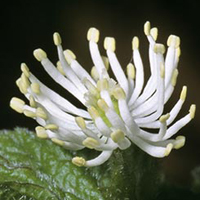Goldenseal
Scientific name: Hydrastis canadensis


Cover photos credit: Allen Woodliffe
Status
Special concern
Special concern
means the species lives in the wild in Ontario, is not endangered or threatened, but may become threatened or endangered due to a combination of biological characteristics and identified threats.
Date added to the Species at Risk in Ontario list
The Goldenseal was already assessed as at-risk when the Endangered Species Act took effect in 2008.
Read the most recent assessment report (PDF)
What it looks like
Goldenseal is a perennial herb with an erect stem covered with fine hair that can grow up to 50 centimetres high. It has three leaves, one at the base and two on the upper part of the stem. Leaves are five-lobed, doubly toothed, reaching a width of 25 centimetres.
The flowers are distinctive in that they lack showy petals or sepals but have conspicuous, showy white stamens. The inedible fruit resembles a dark red raspberry and contains up to 30 small, dark brown or black seeds.
The common name of the plant refers to the bright yellow bulb that bears the scars of previous stems and resembles the wax seals once used to close letters.
Where it lives
Goldenseal grows in rich, moist semi-open to closed areas of deciduous forests. It is found at periodically flooded upland sites and in moist lowlands near floodplains.
It is associated with Red Oak, Sugar Maple, Hawthorns, Shagbark Hickory, Ironwood and Basswood. The species typically grows in disturbed areas where trees have fallen, or next to recreational paths or woodland edges.
It prefers sandy loam, loam soils or clay soils depending on whether it is growing in an upland or lowland area.
Where it’s been found in Ontario
Goldenseal is widespread, but rare, throughout its eastern North American range, which extends from southern Ontario and New England south to Georgia and Arkansas and west to Kansas and Oklahoma.
In Canada, it is found only in extreme southwestern Ontario in the Carolinian Zone.
What threatens it
Habitat loss and degradation is the primary threat to Goldenseal, along with changes to flooding and drainage regimes.
Harvesting for medicinal uses is also considered a significant threat as almost all of the Goldenseal sold in Canada comes from wild populations.
Action we are taking
Special concern species do not receive species or habitat protection.
Recovery strategy
A recovery strategy advises the ministry on ways to ensure healthy numbers of the species return to Ontario.
Read the executive summary and full document (June 2, 2016)
Government response statement
A government response statement outlines the actions the government intends to take or support to help recover the species.
Read the government response statement (March 2, 2017)
Review of progress
A review of progress made toward protecting and recovering a species is required no later than the time specified in the species’ government response statement, or not later than five years after the government response statement is published if no time is specified.
Read the report on progress towards the protection and recovery of 12 species at risk, including Goldenseal (2022).
Habitat protection
General Habitat Protection - June 30, 2013
What you can do
Report a sighting
- Report a sighting of an endangered animal or plant to the Natural Heritage Information Centre. Photographs with specific locations or mapping coordinates are always helpful.
Volunteer
- Volunteer with your local nature club or provincial park to participate in surveys or stewardship work focused on species at risk.
Be a good steward
- Private land owners have a very important role to play in species recovery. If you find Goldenseal on your land, you may be eligible for stewardship programs that support the protection and recovery of species at risk and their habitats.
- Invasive species seriously threaten many of Ontario’s species at risk. To learn what you can do to help reduce the threat of invasive species, visit:
- Consult the Ministry of Natural Resources when working around forests for information on provincial regulations and best management practices to protect these important habitats. Call toll free 1-800-667-1940.
- The Carolinian forests of southern Ontario support an amazing diversity of plants and wildlife, including many species at risk. Carolinian Canada is working to help recover species at risk and their habitats.
- The Canada-Ontario Farm Stewardship Program is available to farmers registered under the Canada-Ontario Environmental Farm Plan to encourage greater protection and conservation of habitat for species at risk.
Report illegal activity
- Report any illegal activity related to plants and wildlife to
1-8766-MOE-TIPS (663-8477) .
Quick facts
- A tea made from the roots of Goldenseal was used in traditional aboriginal medicine to treat a variety of complaints including ulcerated or inflamed mucous membranes. This plant continues to be popular in herbal medicine today, but only farm-grown Goldenseal should be used owing to its extreme rarity in the wild.
- Goldenseal is one of the few at-risk woodland plants that do well in disturbed sites. Natural forms of disturbance includes fallen trees that opens up areas to light, and foraging by wildlife that results in soil turnover.
- The seeds of Goldenseal may remain dormant in the soil for about 10 months from late July to early May before emerging. However, seedling establishment in Ontario is very low.